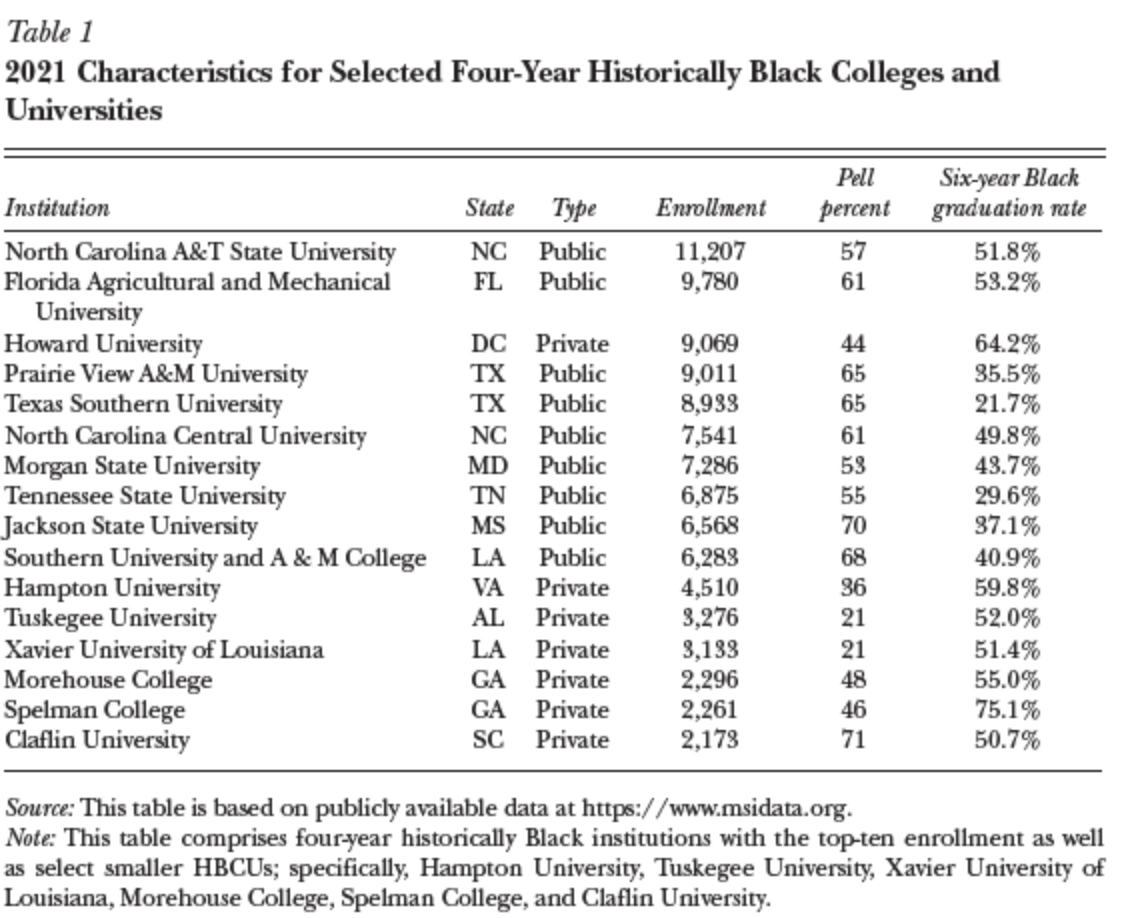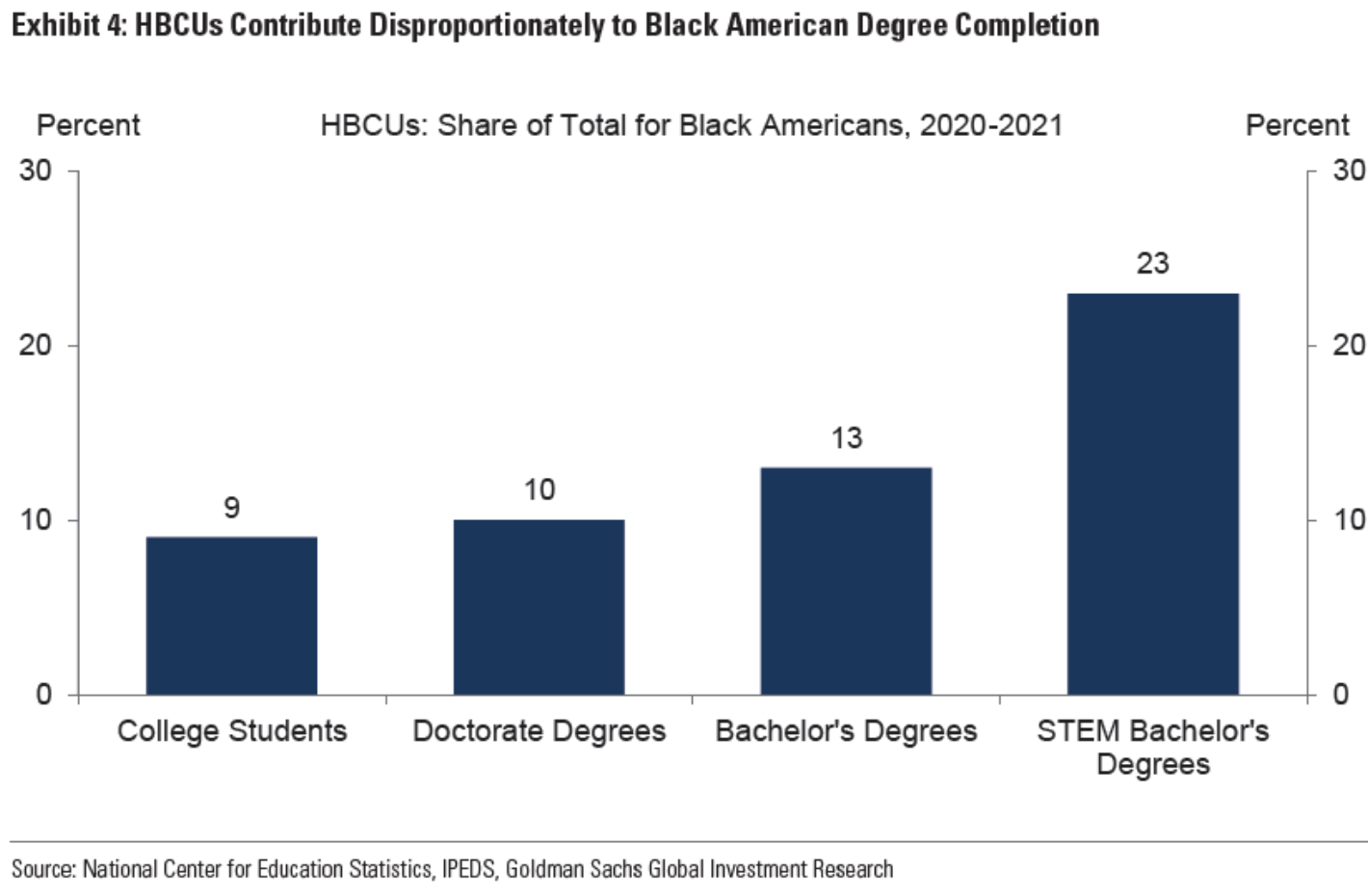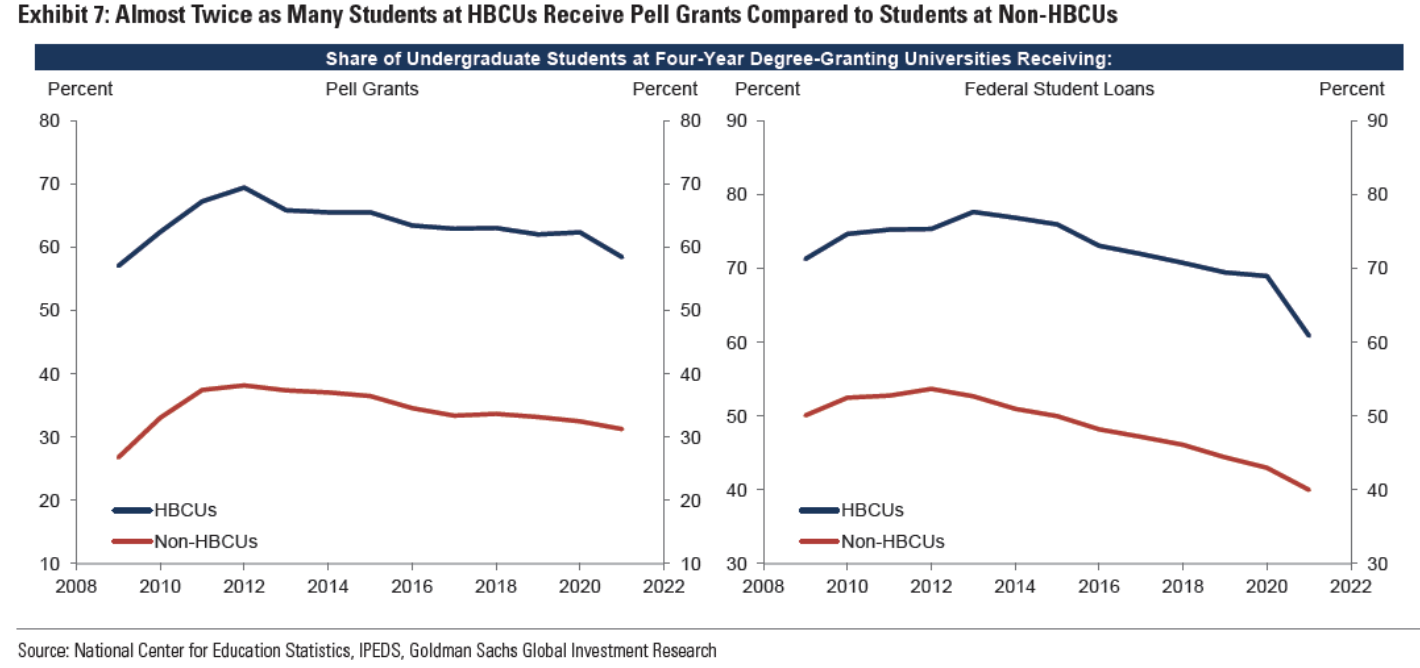Comments
- No comments found

As recently as 1967, about 80% of all black college students graduated from “historically black colleges and universities.” But the ground was shifting.
The 1954 Supreme Court desegregation decision in Brown v. Board of Education, along with the Civil Rights Act of 1964, helped lead to a surge in high school graduates and then rapid growth in black college graduates: “The University of Washington for example, saw its black student enrollment increase from 136 in 1967 to 1,110 in 1971.” As enrollments of black college students expanded dramatically, the share of black students attending the historically black colleges and universities has dropped dramatically, now to about 9%. Of necessity, the role of such institutions is evolving.
The National Center for Education Statistics describes term “historically black colleges and universities” this way (citations omitted):
Historically Black colleges and universities (HBCUs) are institutions that were established prior to 1964 with the principal mission of educating Black Americans. These institutions were founded and developed in an environment of legal segregation … In 2021, there were 99 HBCUs located in 19 states, the District of Columbia, and the U.S. Virgin Islands. Of the 99 HBCUs, 50 were public institutions and 49 were private nonprofit institutions. The number of HBCU students increased by 47 percent (from 223,000 to 327,000 students) between 1976 and 2010, then decreased by 12 percent (to 287,000 students) between 2010 and 2021 …
Although HBCUs were originally founded to educate Black students, they enroll students of other races as well. The composition of HBCUs has changed over time. In 2021, non-Black students made up 25 percent of enrollment at HBCUs, compared with 15 percent in 1976. While Black enrollment at HBCUs increased by 14 percent between 1976 and 2021, the total number of Black students enrolled in all degree-granting postsecondary institutions (both HBCUs and non-HBCUs) more than doubled during this period. As a result, the percentage of Black students enrolled at HBCUs fell from 18 percent in 1976 to 8 percent in 2014 and then increased to 9 percent in 2021.
Gizelle George-Joseph and Devesh Kodnani of Goldman Sachs describe several elements of the evolution in “Historically Black, Historically Underfunded: Investing in HBCUs” (Goldman Sachs Research, June 13, 2023). They emphasize and complement the main themes developed in the article by Gregory N. Price and Angelino C. G. Viceisza in the Summer 2023 issue of the Journal of Economic Perspectives (where I work as Managing Editor): “What Can Historically Black Colleges and Universities Teach about Improving Higher Education Outcomes for Black Students?”
For concreteness, here’s a table of the larger and some of the more prominent HBCUs, with enrollments and graduation rates, from Price and Viceisza:

Here are a few of the main themes common in both essays:
Although the HBCU’s now educate 9% of black college students, they “punch above their weight” in terms of impact, especially in terms of science, technology, engineering, and mathematics (STEM) majors. From the Goldman Sachs report:

Moreover, a disproportionate share of black college students who get PhDs from all institutions started out at HBCUs. Price and Viceisza point out:
Almost one-quarter (23.2 percent) of Black graduates who earned a doctorate in science and engineering between 2015 and 2019 earned their bachelor’s degree from a historically Black college or university (National Science Foundation 2021). Historically Black institutions produced particularly large shares of baccalaureate recipients who later earned doctoral degrees in agricultural sciences and natural resources (almost 50 percent of all Black graduates who earned such a degree), computer and information sciences (over 30 percent), and mathematics and statistics (over 30 percent). The top producers were Howard University and Spelman College.
Moreover, HBCUs accomplish these outcomes while enrolling a disproportionately large share of students coming from lower-income households. One measure of this difference is in the share of HBCU students receiving federal Pell grants or student loans. From the Goldman Sachs report:

In their JEP essay, Price and Viceisza discuss the evidence HBCUs are finding ways to overcome the disadvantaged for the socioeconomic background of the students they are admitting. It turns out that if one adjusts for characteristics of students and their families (like income and parental education) and for characteristics of colleges (like selectivity and funding), black students at HBCUs are more likely to graduate and to enter science and technology careers than black students at other institutions. These gains for HBCUs are especially large when comparing black students entering college with lower test scores. In studies that seek to measure what colleges have the biggest effect in leading to intergenerational gains in earnings (a measure that combines both the student’s family background, the chance of graduating, and the after-graduation work experience), HBCUs often rank near the top.
In their evolution during the last few decades, the HBCUs have clearly figured out how to do more with less. The problem of underfunding at the HBCUs is longstanding. It of course goes back to the times of legalized segregation, but persisted after that. As Goldman Sachs authors note: “In 1986, Congress amended the Higher Education Act of 1965 to increase funding for HBCUs in response to their finding that state and federal institutions had engaged in discriminatory practices that had financially disadvantaged HBCUs.”
Whatever the merits of the 1986 law, the financial gaps have persisted. Price and Viceisza write:
Finally, a substantial boost in funding for historically Black colleges and universities seems appropriate and overdue. These institutions were dramatically underfunded on a per-student basis during decades of legalized segregation (Smith 2021). Colleges and universities are long-lived institutions, and underfunding from decades ago will affect the physical inheritance of these institutions today: academic buildings, library resources, greenspaces, athletic facilities, and more. This underfunding has continued up to the present. Lawsuits about underfunding of historically Black institutions have been settled in recent years by Maryland, Alabama, and Mississippi, and a similar lawsuit was recently announced in Florida. Two journalists at Forbes calculated that Black land-grant universities have been underfunded at the state level, relative to their primarily white counterparts in the same states, by $12.8 billion in the last three decades (Adams and Tucker 2022).
I don’t want to over-claim what HBCUs can accomplish. After all, their successes come from students who choose to attend these institutions. It’s not obvious to me that they have some secret sauce that would work equally well for all Black students, or for students of all racial/ethnic backgrounds, at other institutions as well. But clearly, they do know something, and the successes of HBCUs in reaching out to students who traditionally have had a lesser chance of flourishing in college makes them a worthy object of increases in both attention and funding.
Timothy Taylor is an American economist. He is managing editor of the Journal of Economic Perspectives, a quarterly academic journal produced at Macalester College and published by the American Economic Association. Taylor received his Bachelor of Arts degree from Haverford College and a master's degree in economics from Stanford University. At Stanford, he was winner of the award for excellent teaching in a large class (more than 30 students) given by the Associated Students of Stanford University. At Minnesota, he was named a Distinguished Lecturer by the Department of Economics and voted Teacher of the Year by the master's degree students at the Hubert H. Humphrey Institute of Public Affairs. Taylor has been a guest speaker for groups of teachers of high school economics, visiting diplomats from eastern Europe, talk-radio shows, and community groups. From 1989 to 1997, Professor Taylor wrote an economics opinion column for the San Jose Mercury-News. He has published multiple lectures on economics through The Teaching Company. With Rudolph Penner and Isabel Sawhill, he is co-author of Updating America's Social Contract (2000), whose first chapter provided an early radical centrist perspective, "An Agenda for the Radical Middle". Taylor is also the author of The Instant Economist: Everything You Need to Know About How the Economy Works, published by the Penguin Group in 2012. The fourth edition of Taylor's Principles of Economics textbook was published by Textbook Media in 2017.
Leave your comments
Post comment as a guest